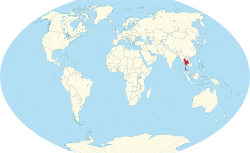Biology:Nymphaea siamensis
| Nymphaea siamensis | |
|---|---|
| Scientific classification | |
| Kingdom: | Plantae |
| Clade: | Tracheophytes |
| Clade: | Angiosperms |
| Order: | Nymphaeales |
| Family: | Nymphaeaceae |
| Genus: | Nymphaea |
| Species: | N. siamensis
|
| Binomial name | |
| Nymphaea siamensis Puripany.[1]
| |

| |
| Nymphaea siamensis is endemic to Thailand[1] | |
Nymphaea siamensis is a species of waterlily endemic to Thailand.[1]
Description
Vegetative characteristics
Nymphaea siamensis has ovoid, erect, 15 cm long and 5 cm wide rhizomes with oval bulblets. The broadly elliptic to ovate, 25 cm long, and 23 cm wide leaves have a subcoriaceous texture. The green adaxial surface can display reddish brown spotting. The purplish red abaxial surface features brown spotting. The brown, glabrous, 4 mm wide petioles have four primary air canals.[2]
Generative characteristics
The sterile, 8–12 cm wide flowers float on the water surface. They are attached to reddish brown, glabrous, 6.5 mm wide peduncles with six primary central and twelve secondary peripheral air canals. The 5-8 green, elliptic-ovate, 5 cm long, and 1.5 cm wide sepals have a rounded to acute apex. The 80-90 petals display pinkish white, and green colouration. Reproductive structures are absent.[2] The flowers are said to resemble Chrysanthemum flowers.[3]
Reproduction
Vegetative reproduction
The clonal species Nymphaea siamensis reproduces exclusively through the formation of bulblets on the rhizome, as well as occasional tubiferous flowers.[2]
Generative reproduction
Sexual reproduction is impossible in this species. The flowers are sterile and do not produce ovaries.[4][2]
Taxonomy
It was first described by Puripany. in 2014.[1]
Type specimen
The type specimen was collected by W.La-ongsri in Chiang Mai, Queen Sirikit Botanic Garden, Thailand on the 20th of August 2000.[5][2]
Placement within Nymphaea
It appears to be placed in Nymphaea subgenus Brachyceras,[2] however the absence of fertile flowers make it difficult to place.[4]
Etymology
The specific epithet siamensis refers to Siam, a former name of Thailand.[6]
Cultivation
It is easily cultivated.[2]
References
- ↑ 1.0 1.1 1.2 1.3 "Nymphaea siamensis Puripany." (in en). Royal Botanic Gardens, Kew. http://www.plantsoftheworldonline.org/taxon/77141571-1. Retrieved 27 December 2023.
- ↑ 2.0 2.1 2.2 2.3 2.4 2.5 2.6 Puripunyavanich, V., La-ongsri, W., Boonsirichai, K., & Chukiatman, P. (2013, July). "Nymphaea siamensis, the new species of waterlily in Thailand." In VI International Symposium on the Taxonomy of Cultivated Plants 1035 (pp. 87-98).
- ↑ Khensri, C., Putanyawiwat, P., & Hongtrakul, V. (2022). "Molecular systematics of notable Nymphaea cultivars in Thailand based on multiple chloroplast DNA specific sites." Agriculture and Natural Resources, 56(6), 1091-1102.
- ↑ 4.0 4.1 Puripunyavanich, V., Chukiatman, P., La-ongsri, W., Limtiyayotin, M., Maikaeo, L., Kongsri, S., & Kukusamude, C. (2021, July). "Thai native waterlilies survey as an evidence to support Jongkolnee waterlily (Nymphaea siamensis) in new subgenus." In IX International Scientific and Practical Conference on Biotechnology as an Instrument for Plant Biodiversity Conservation 1339 (pp. 13-20).
- ↑ Nymphaea siamensis | International Plant Names Index. (n.d.). Retrieved December 27, 2023, from https://www.ipni.org/n/77141571-1
- ↑ Species: Asaia siamensis. (n.d.). LPSN - List of Prokaryotic Names With Standing in Nomenclature. Retrieved December 27, 2023, from https://lpsn.dsmz.de/species/asaia-siamensis
Wikidata ☰ Q91446868 entry
 |

